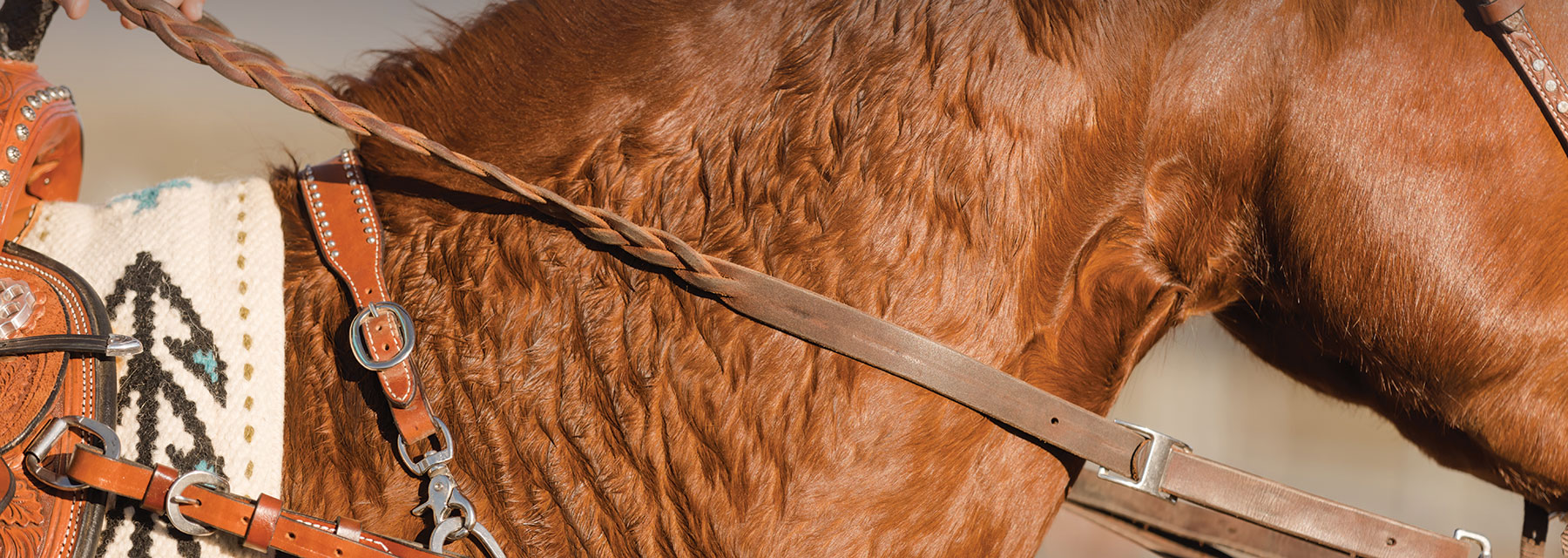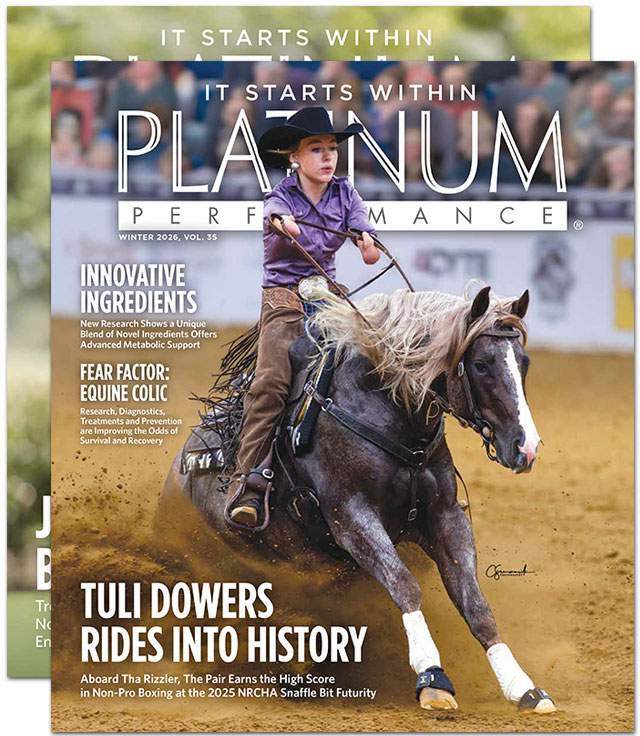We love summer. The wait is over for sun, fun and spending the longer days with our horses. Summertime also brings the heat, so it is important to know equine vital signs — how to cool a hot horse and ensuring proper hydration — so that you both can enjoy a worry-free season.

Your veterinarian will be able to help make sure that your horse stays healthy in the heat.
Your veterinarian will be able to help make sure that your horse stays healthy in the heat.
Heat Stress and What to Do About It
Horses are more susceptible to heat stress in the summer months due to hotter temperatures and higher humidity. Heat stress occurs when there is a breakdown in the way a horse normally cools itself — typically when sweat is not able to evaporate and allow for proper cooling. Warning signs precede heat stroke, which is a medical emergency when a horse’s internal body temperature becomes too high. Knowing a horse’s vital signs as well as symptoms of heat stress can prevent an urgent situation.
If untreated, heat stress can quickly become heat stroke, which can lead to death. Contact your veterinarian immediately if you suspect heat stroke or your horse is in distress. If you aren’t certain, call your veterinarian, who will be able to help and make sure that your horse stays healthy in the heat.
“Here in southeast Texas, it’s common to be 100 degrees with high humidity in the summer. I tell my clients to pay attention to your horse and make sure that they stay hydrated. Offer clean, fresh water at all times, including during exercise. Don’t ride at the hottest part of the day, and take the appropriate precautions to cool down after exercise. Let them relax and walk until they aren’t breathing hard, then hose off with cool water. Let them dry under fans if you can. When it’s hot you have to take extra precautions to keep horses safe.”
— Dr. Clayton Smith, Smith Equine Performance, Cypress, Texas
Signs of Heat Stress
- High body temperature (rectal temperature above 102 degrees Fahrenheit)
- Increased heart rate (may not return to normal even after rest)
- Increased breathing rate (rapid breathing or panting with flared nostrils)
- Profuse sweating
- Droopy ears
- Hot skin
- Dehydration (tacky mucous membranes — eyes and gums — lack of skin elasticity, reduced urination)
- Lethargy (horse may appear tired and weak)
- Reduced feed intake
Cooling an Overheated Horse
- Move to shaded area, ideally with a breeze or fan.
- Spray the horse’s entire body continuously with cool water.
- Offer water for fluid replacement.
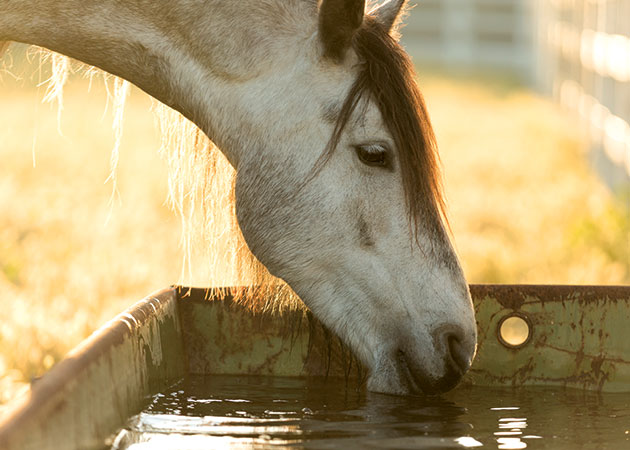
Facts from the Watering Hole
- Horses drink an average of 5-10 gallons of water daily at moderate temperatures.
- If a horse is on a diet of dry hay only, water consumption may double.
- Sweat losses increase water intake needs by 50-200%.
- A 1,100-pound horse exercising in hot or humid conditions for an hour requires 19-24 gallons of water to replace sweat and evaporative losses.
- Working horses should be offered water at least once an hour during extended exercise periods.
Did You Know?
Making up nearly 70% of the horse’s total weight, the horse needs water to see, hear, breathe, move, to lubricate its joints, cushion the brain and spinal cord, digest food, excrete waste and thermoregulate body temperature.
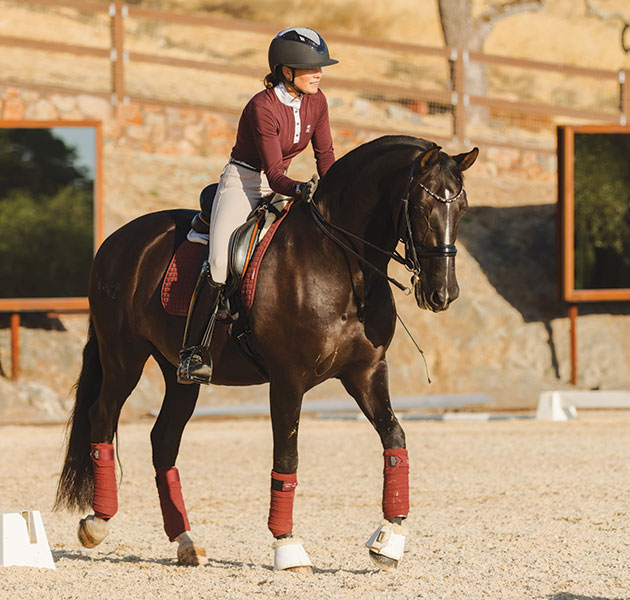
The average horse will drink eight to 20 times each day depending on the temperature, humidity and amount of work and exercise. An average-sized mature horse will drink 5-10 gallons when the temperature is 68 degrees F.
The average horse will drink eight to 20 times each day depending on the temperature, humidity and amount of work and exercise. An average-sized mature horse will drink 5-10 gallons when the temperature is 68 degrees F.
The Importance of Hydration
Water is the most important nutrient for all life, and deprived of it, a horse can die within 48 hours. Fresh, clean water should be available at all times. It is critical because it is incorporated into every cell of the trillions within the equine body. Making up nearly 70% of the horse’s total weight, the horse needs water to see, hear, breathe, move, to lubricate its joints, cushion the brain and spinal cord, thermoregulate, digest food, excrete waste and thermoregulate body temperature.
To hydrate, horses not only drink water but also ingest it from various feeds, hay and pasture. Equines are capable of creating their own metabolic water through the breakdown of carbohydrates, proteins and fats during normal metabolism. Drinking water is the most efficient method of hydration. The average horse will drink eight to 20 times each day depending on the temperature, humidity and amount of work and exercise. The volume depends on several factors: age, life stage, exercise level, type of feed consumed and the ambient temperature. An average-sized mature horse, weighing 900-1,200 pounds, will drink between five to 10 gallons when the temperature is 68 degrees F. As temperatures increase, the amount of water consumed increases significantly. It will range between 11 and 15 gallons for the same horse at 86 degrees F, and 19-24 gallons when exercising moderately in 95-degree heat. Water is excreted through urine, feces, respiration, skin losses and sweat, as well as in milk during lactation.
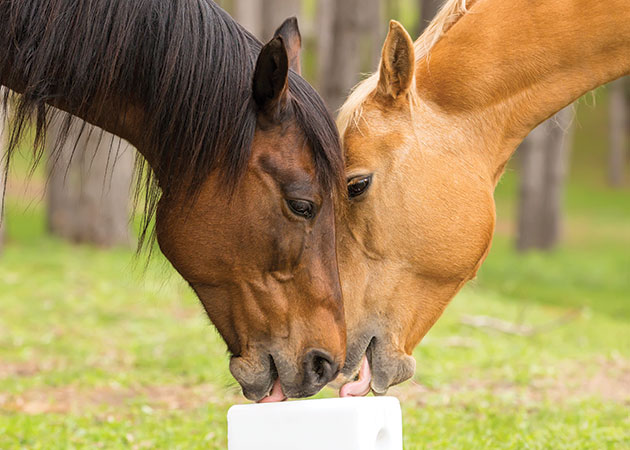
How Does My Horse Stay Hydrated?
Hormones regulate water balance and hydration. The antidiuretic hormone (ADH) regulates sodium and water levels within the blood. If a horse does not consume enough water, ADH from the pituitary gland will signal the kidneys to retain water in order to dilute the blood. The horse will urinate less to conserve water, and its urine will become more concentrated. If the horse is consuming enough water but not enough sodium, the hormone aldosterone from the adrenal gland will signal the kidney to start saving sodium and will excrete potassium in its place, the same as in humans. Due to increased excretion, it may seem logical to supplement potassium lost in sweat back into the diet, but it is actually a lack of sodium that should be addressed. If adequate salt is provided, the horse will drink enough water under normal conditions. Monitoring fluid balance in this way is one of the basic functions of electrolytes, or body salts that break down into positive or negative ions as they dissolve. It is an amazingly simple yet essential way that the horse’s body operates to naturally create shifts of electrolytes, which in turn will influence body fluids and other ions to adjust their concentrations for hydration and health.
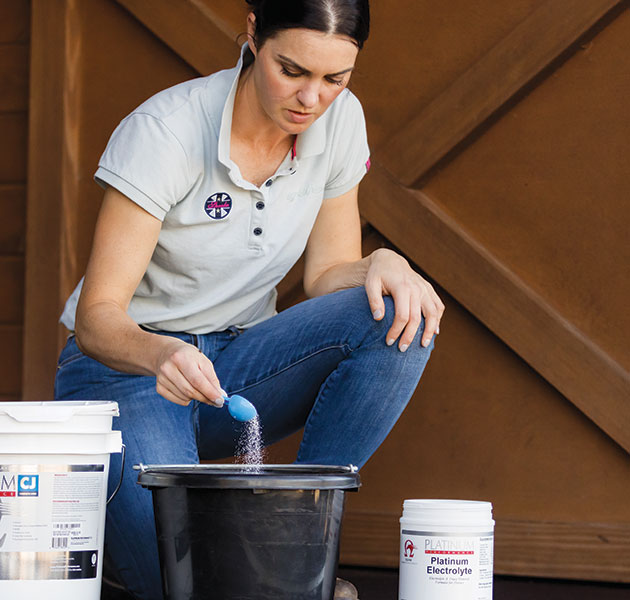
Supplementary electrolytes may be necessary to replace those minerals lost in sweat from hot temperatures, humidity or heavy work.
Supplementary electrolytes may be necessary to replace those minerals lost in sweat from hot temperatures, humidity or heavy work.
Hydration Tips and Tricks
- Fresh, clean water should always be available. Hot, humid weather conditions will increase water consumption.
- Salt should be available free choice or administered daily to satisfy maintenance requirements of sodium. Electrolyte supplementation is specifically to replace minerals (including salt) lost through sweat.
- Plain white salt should be made available as a block or as loose salt, even while traveling at horse shows. Avoid mineralized (red) blocks as some horses will not consume them because of the bitter taste. Or, if they are sweetened with sugar or molasses, equines may consume too much. Horses do not self-regulate mineral consumption (with the exception of edible salt).
- A 5-pound salt block should be consumed within two months. If a horse is not consuming at this approximate rate, try offering loose salt instead. Salt blocks and bricks were created for cattle with rougher tongues, and some horses do not like to use that form. Loose salt may be useful to try especially in cold weather when the blocks can freeze and are less inviting to use.
- For maintenance purposes, an ounce of salt (about 2 tablespoons) is an appropriate amount to add to a horse’s daily diet in cool weather and can be doubled in hot and humid conditions.
- Supplementary electrolytes may be necessary to replace those minerals lost in sweat from hot temperatures, humidity or heavy work.
- Horses need access to fresh water after receiving electrolytes. If electrolytes are offered in the water, provide an additional fresh water source as well.
- To prevent ulcers, give electrolytes with feed, or wait until after the horse has eaten to administer. For orally syringed electrolytes, use a liquid antacid or small amount of vegetable oil as the carrier for electrolyte powder.
- Administer electrolytes immediately after the horse has had a drink, preferably after a few gallons.
- Electrolytes are minerals with a very long shelf life. Keep some on hand at the barn for when needed.
- Check the label. Electrolyte supplements should not contain sugar. Salt should be the first and primary ingredient and at least 75% of the total.
“Have a plan before it gets to the middle of summer. Prevention and planning are really important, so that if you get into an emergency situation, you don’t have to think about what to do, you just have to follow the protocol. Know what is normal for your horse, in order to be aware of abnormal. Know the signs of heat stress. Have your veterinarian’s phone number posted in the barn, so that anyone can call if they think a horse is struggling in the heat, or anytime.”
— Dr. Clayton Smith, Smith Equine Performance

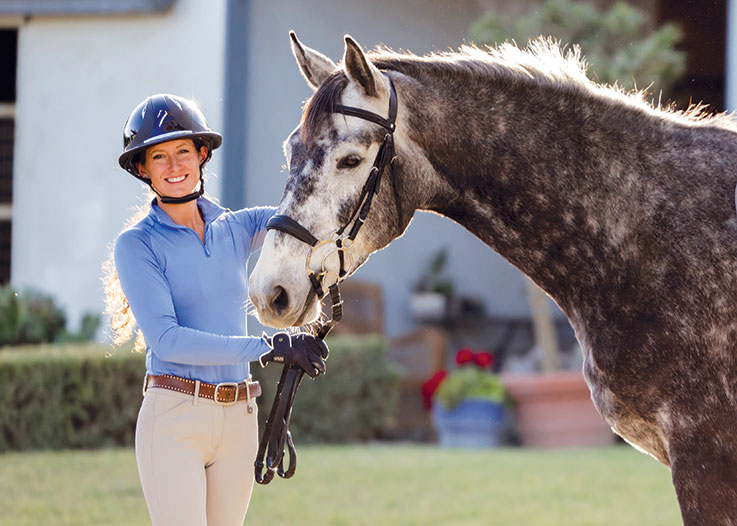
Signs of Dehydration
Dehydration can be a life-threatening condition and precipitate many serious health issues including heat stress and colic. Watch for signs that your horse may not be drinking enough water in order to address the problem before it becomes a more severe issue.
- Water Intake: Although automatic waterers offer a convenient way for horse owners to make sure their horses always have water, most do not keep track of how much water your horse consumes each day. If you have concerns that your horse is not drinking, turn off the automatic device and supply buckets to better track how much water your horse consumes.
- Consistency of Manure: Examining manure can provide physical evidence about what’s going on within your horse’s gut. Very dry or hard manure, and/or smaller than normal fecal balls can be a sign of dehydration and/ or impaction. Make a mental note of what your horse’s normal manure looks like and when cleaning stalls or riding use it as a reference when something is unusual.
- Gum and Capillary Refill Test: A hydrated horse’s gums should be moist and pink. When a finger is pressed firmly against the gums and released, the pressure point should return to its pink color within 1-2 seconds. Try this first when your horse is hydrated so you know what hydrated gums should look like.
- The Pinch Test: Another hydration test involves checking for skin elasticity. When you pinch and release the skin on your horse’s neck, it will quickly return to normal on a hydrated horse; however, pinch testing a dehydrated horse will form a wrinkle that can take up to 5 seconds to disappear. Try this first on a fully hydrated horse so you understand what to look for.
It is important to contact your veterinarian if you think your horse is showing any signs of dehydration.
Equine Hydration Influencers
Feed: Type, Amount and Quality
- Fresh pasture can contain between 60- 80% water content. Depending on geography, a large amount of equine water requirements can potentially be supplied by pasture grazing.
- Hay has a low moisture content. Horses on a hay-only diet will need to drink more water to meet their needs.
- A diet of high protein and/or high sodium will increase the water requirement due to increased urinary output.
Environment: Temperature and Humidity
- Temperatures above 85 degrees F will increase both drinking frequency and total water volume.
- Temperatures below 45 degrees F will often reduce water consumption.
Life Stage
- The type of physical activity and exertion level will affect water requirements.
- Lactating mares may require up to four times the amount of water compared to an average horse to sustain milk output.

Sweat is the major mechanism for removing excess body heat. The amount produced depends on environmental conditions, type of work or exercise performed and the horse’s individual fitness level.
Sweat is the major mechanism for removing excess body heat. The amount produced depends on environmental conditions, type of work or exercise performed and the horse’s individual fitness level.
Sweat and Electrolytes
It is vitally important to replace water and electrolyte lost to sweat to alleviate the risk of thermoregulatory dysfunction, imbalances and dehydration. Sweat is the major mechanism for removing excess body heat from the horse. The amount produced depends on several factors: environmental conditions; type of work or exercise performed; and the horse’s individual fitness level. Sweating prevents overheating through evaporative cooling. Be aware of the heat index, which is the sum of the outside temperature (F) and the humidity percentage. When heat and humidity are high, and the index is 130-150, the equine body’s ability to dissipate heat through evaporation is impaired. When the index is greater than 150 there is moderate risk of overheating and heat stress.
Sweat, which is essential to cooling, is made up primarily of water and electrolytes, the charged minerals necessary to maintain fluid balance and the body’s acid-base balance. These body salts influence circulatory function and blood volume, as well as trigger muscle contractions and nerve impulses.
Electrolytes circulate in blood or tissue fluid and in cells. The main electrolytes needed in the horse’s body include: sodium, potassium, chloride, magnesium and calcium. Sodium and chloride are the major electrolytes in blood and extracellular fluid, while potassium is the main intracellular electrolyte found in the fluid within cells, comprising about 40% of the body’s total water volume. All electrolytes are required for daily functioning and maintenance, most of which the horse typically consumes from a normal forage-based diet, with the exception of sodium. Pasture and/or hay provide plentiful potassium and chloride to meet the maintenance requirements of most horses, but the diet is nearly always deficient in sodium. For this reason, all horses should always have access to a plain white salt block or loose salt to satisfy sodium requirements. Ensuring a horse has access to fresh water and salt goes a long way for proper hydration and electrolyte replacement.
Supplementary electrolytes become important when horses are sweating more than they would under normal, ambient conditions. Most performance horses or horses training with heavy or prolonged work — especially in summer weather — will require additional electrolytes as even mild dehydration can be harmful. Horses exercising even at a moderate level lose more than a gallon of sweat per hour. Electrolyte deficiencies are associated with general fatigue, and muscle weakness and exhaustion that can lead to tying up, as well as reduced sweating that can cause heat stroke, or hyperthermia, and compromised performance. Lethargy and reduced feed and water intake can precede weight loss and dehydration associated with decreased intestinal motility and colic.
The requirements for electrolytes are substantially increased above maintenance requirements as sweat drains a huge quantity of electrolytes, particularly sodium, potassium and chloride. Sweat also contains water, protein and lower levels of calcium, magnesium and phosphate, as well as small amounts of trace elements like zinc, manganese and iron. Supplements should mimic the proportion of losses from sweat. For every 100 parts of sodium in sweat, there are about 80 parts of potassium and 200 parts of chloride. Horses in moderate work in cool weather probably do not require electrolyte supplementation. Performance horses or those exercising in hot climates and sweating do. Horses that are prone to tying up or muscle soreness should also be considered for electrolyte supplementation. Supplementing electrolytes post-exercise will effectively induce water consumption. Electrolyte losses should be replaced soon after exercise in most cases.
Severe electrolyte deficiencies are a medical emergency and can result in complete exhaustion, colic, synchronous diaphragmatic flutter (thumps), collapse and death if not treated medically. A veterinarian should be contacted immediately if a horse is suspected to be acutely dehydrated.
Normal Equine Vital Signs
What is Normal for Your Horse
- Temperature: 99-101.5 degrees F is the range for the horse population, but it is better to know what is normal for your individual horse(s).
- Respiratory Rate: 10-24 breaths per minute.
- Heart Rate: 28-44 beats per minute.
- Mucous Membranes: Normal gums are moist and pink.
- Capillary Refill Time: When a finger is pressed firmly against the horse’s gums, the pressure point should regain its pink color within 1-2 seconds.
- Intestinal Sounds: Gurgling, gas-like growls, tinkling sounds and occasional roars are normal and can even be heard pressing an ear to the horse’s barrel.
You May Also Enjoy
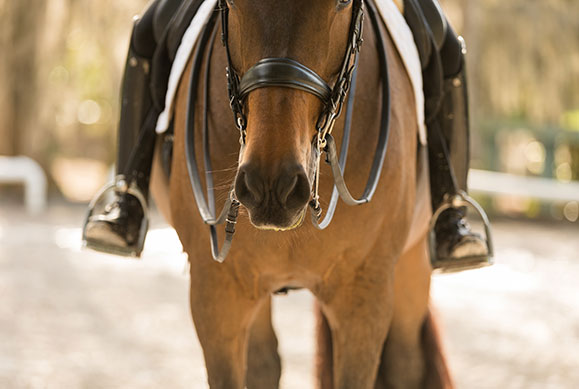
Top 10 Summer Horse Health Tips
Help Your Horse Beat The Heat
Read More about Summer Health Tips for Horses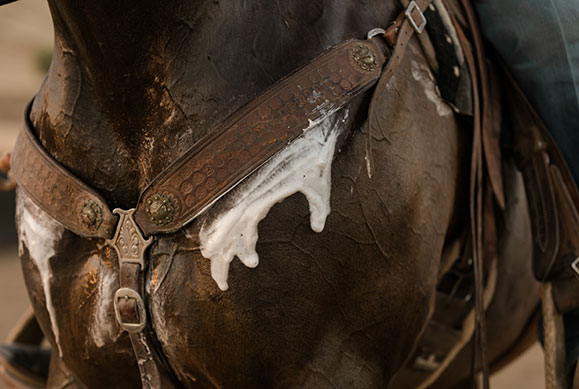
Non-Sweating & Electrolytes
Nutrition To Support Your Horse This Summer
Read More about Non-Sweating in Horses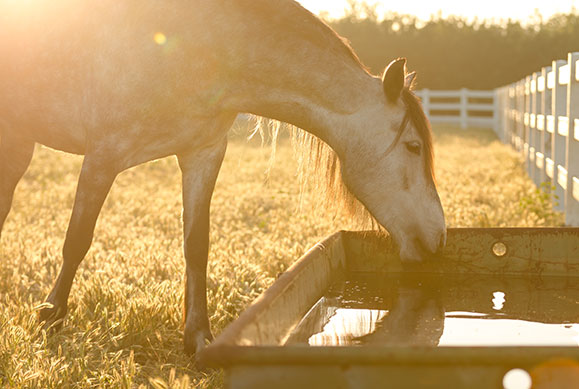
It's Getting Hot Out There
How To Support Your Horse Through The Hot Summer
Read More about Supporting Your Horse Through Summer